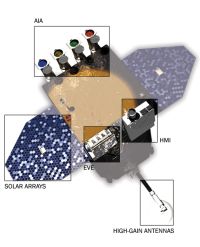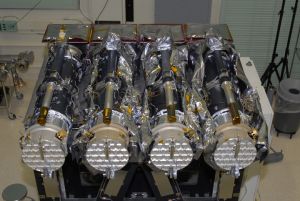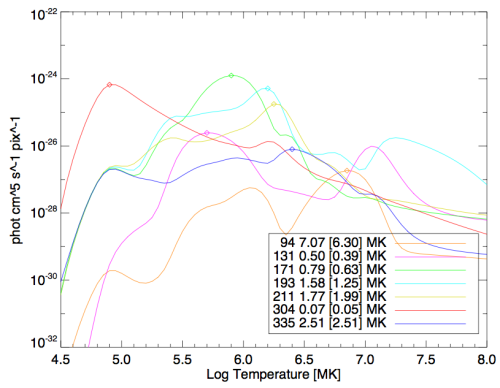M is for Magnifique
| Nugget | |
|---|---|
| Number: | 141 |
| 1st Author: | Steven Christe |
| 2nd Author: | Andy Inglis |
| Published: | 6 December 2010 |
| Next Nugget: | Brilliant Timing |
| Previous Nugget: | Major Flare Watch Evaluation |
Introduction
On October 12th, new magnetic flux began to emerge in the middle of the negative-polarity region of active region 11112. This emerging flux continued to grow over the next few days stressing the already existing fields and presumably building up magnetic energy. A few days later, on October 16th, the pent-up energy was finally released through an M-class flare (SOL2010-10-16T19:12). The region went on to produce a few C-class events before rotating around the limb, but in a sense its master-work was over. This Nugget concerns this M-class flare which was simultaneously observed by [RHESSI] and the Solar Dynamics Observatory (SDO). Here, we focus on the AIA observations from SDO, which are unique due to the fact that this is the first flare for which AIA's automatic exposure control was enabled. In a future Nuggets, we will take a look at the SDO EVE observations, a subject which we have already visited in a previous Nugget, and other topics such as loop oscillations which AIA is particularly good at observing.
Introduction to AIA
First a quick introduction to SDO's AIA, since we have not yet discussed this important new instrument. The Atmospheric Imaging Assembly (AIA) is one of three instruments on board the Solar Dynamics Observatory (SDO). AIA consists of four telescopes, each imaging at multiple wavelengths, and provides full-disk solar images with a pixel size of 0.6 arcseconds and a time cadence of around 12 seconds. Unlike RHESSI, SDO observes the Sun continuously, barring occasional eclipse periods. These guaranteed observations coupled with the unprecedented combination of spatial and temporal resolution have opened up a treasure trove of possibilities for observations of solar global waves. AIA takes solar images not only at the traditional SOHO/EIT wavelengths of 171 Å and 193 Å, but also in the 94 Å, 131 Å, 211 Å, 304 Å and 335 Å bands. Thus, for the first time, simultaneous consistent high-resolution full disk imaging of the Sun at a broad range of different temperatures is possible (see Figure 1). Combined with RHESSI observations, interesting new discoveries are surely on the horizon.
|
Automatic Exposure Control (AEC)
The large increase in intensity during flares poses a problem for most detectors. In RHESSI's case, we use movable metal shutters which come in automatically when needed and block out the large thermal fluxes at low energies. For an EUV imager such as AIA, high fluxes can be mitigated by simply changing the exposure time of the images just like in optical photography. The October 16th flare is the first flare for which automatic exposure control (AEC) was operating, and therefore it provides an interesting test case for the SDO team's current strategy for AEC. The following movie shows AEC in action in the 171 Å band.
{{#widget:YouTube|id=B-wKkuj4b_o}}
The flickering is due to the fact that AEC is only enabled every other frame. This strategic choice is to make sure that there is always an overexposed frame available throughout the flare in order to be able to see the fainter global structure surrounding the flare. Comparing different channels, it is also clear that AEC works on every AIA channel independently. A closer look at an underexposed compared to overexposed frame can be seen in Figure 4 and Figure 5.
From the figures above it is clear that AEC significantly reduces saturation in large flares though it is clear that there is still some left over. There is still some work to do to tweak the AEC algorithm. Yet even still, compared to the RHESSI images, AIA images show a wealth of detail. While RHESSI contours suggest some sort of thermal loop and two footpoints, underlying AIA loops show a much more complex structure is at work here; not just a single loop. Note that there seems to be some displacement between the RHESSI and AIA images which has not been corrected. This is likely to be the result of incorrect roll coordinate information in the AIA data, which will no doubt improve with better calibrations.
Waves?
Maintaining information on the global structure can be important since flares are known to create traveling disturbances such as Moreton or EIT waves, which can propagate across the solar disk and disturb nearby magnetic field structures. Related disturbances set up local standing waves, the substance of the new field of coronal seismology. All of these waves, both standing and traveling, are interesting in that they can give us information which is usually hard to come by such as the magnetic field strength. In addition, AIA, with its steady cadence, full sun field of view and good sensitivity, is an excellent platform to spot this types of events. Taking a look at the 94 Å band, a higher temperature channel, it is clear that this flare is associated with some sort of propagating disturbance (check out the following movie to see it in action).
{{#widget:YouTube|id=yUd_RwPSFIA}}
A quick back-of-the-envelope calculation suggests that this disturbance is traveling close to 1000 km/s! This value is strangely close to CME speeds yet the coronagraph data suggest that no CME occurred at this time; there was a type II radio burst (frequently associated with traveling shock waves such as those in CMEs) as reported in the [event list]. We will make sure to take a closer look at this and associated waves in a future Nugget.
Conclusion
We've just begun scratching the surface of AIA data which can provide much more than just context images for RHESSI observations. We will continue to explore this particular event in at least two future Nuggets to showcase the power of combined SDO and RHESSI observations.




